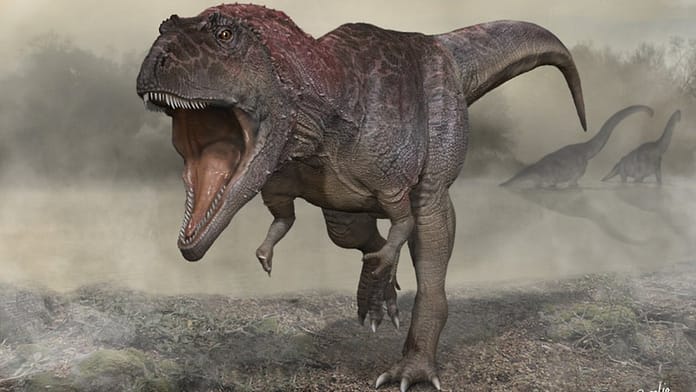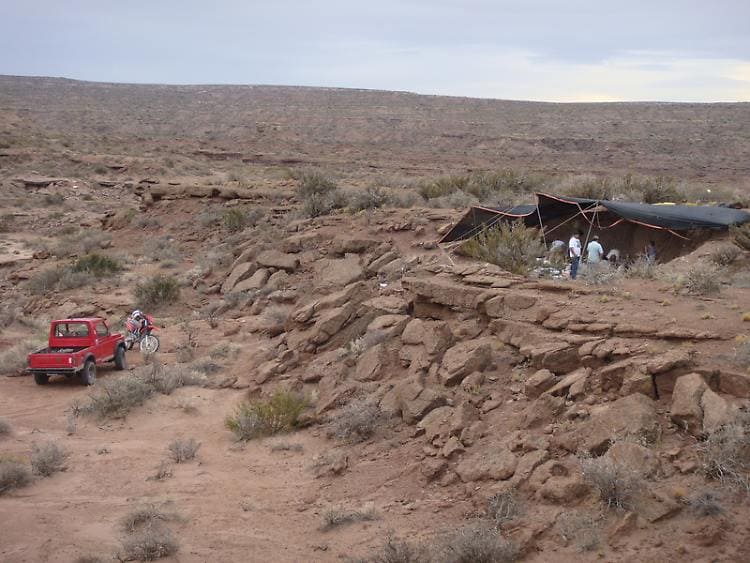A new discovery in Patagonia
Huge dinosaur had short sleeves
7/7/2022 at 8:01 p.m.
A dinosaur with a big skull and short arms – it looks like a T. rex. But it wasn’t the only primitive giant with very short forelimbs: a team of paleontologists made a “interesting discovery” of the bones of a previously unknown predatory dinosaur in Patagonia.
In Patagonia, paleontologists discovered the bones of a predatory dinosaur, with its large skull and short arms, reminiscent of the famous T. rex sore. The researchers reported that despite the outward similarity, the dinosaurs were not related to each other In the journal “Current Biology”. Miraxis Gegas, and the name of the new carnivore, and T. rex independently developed their disproportionately short arms. What they are used for is still not clear.
While excavating the so-called “Huincul Formation” in what is now northern Patagonia, researchers found fragments in the skull, shoulder bones, pelvis, foot, and a connected chain of caudal vertebrae as well as the ulna, tibia and shin bones. According to the researchers, it is the most complete fossil remains of the representative Carcharodontosauridae found in the Southern Hemisphere.
huge predatory dinosaurs
Carcharodontosauridae refers to a large theropod that lived in the Cretaceous period and included giant predatory dinosaurs. Meraxes gigas was just a giant predator: the researchers reported that the discovered specimen, about 45 years old, was 11 meters long and weighed more than four tons when it was alive. His skull, about 1.27 meters long, is decorated with crests, grooves, spurs and squirrels.
“These traits emerged late in evolution, when the animals became adults,” lead author Juan Canal of the Ernesto Bachmann Museum of Paleontology in Neuquén, Argentina, explains in a statement. It supposedly served to attract potential mates: “Sexual selection is one of the powerful elements of evolutionary power. But since we cannot directly observe their behavior, it is impossible to be certain.”
“No direct relationship” to T. rex
However, researchers are sure that Meraxes gigas did not get their remarkably short arms from Tyrannosaurus Rex or vice versa: on the one hand, M. gigas died nearly 20 million years before the appearance of T. rex. On the other hand, the two species are very far apart in the evolutionary tree. Kanal explains that “there is no direct relationship between the two.”
However, if such short arms were developed independently in different species of theropod, one must assume that the shortened limbs had a specific function – and did not shrink simply because they were useless to dinosaurs. In addition, the skeleton showed large muscular attachments and fully developed pectoral corsets. “The arm had strong muscles,” concludes project leader Kanal. However, this muscle strength may not have been used for hunting, because “actions associated with catching prey were most likely done with the head,” says the paleontologist.
Named after the dragon from “Game of Thrones”
Kanal speculates, “They may have used the arms for reproduction, such as carrying the female during mating.” It is also conceivable that the limbs were helpful in getting up again after a fall.
For Juan Canal, the discovery of the well-preserved fossil represents “probably the most exciting point” of his career—however, fans of fantasy in particular should be pleased with the choice of the name for the new species of dinosaur: as the study’s authors wrote, Merax is after a dragon from the epic. “A Song of Ice and Fire” by American writer George R. R. Martin, which was filmed with the series “Game of Thrones”.


